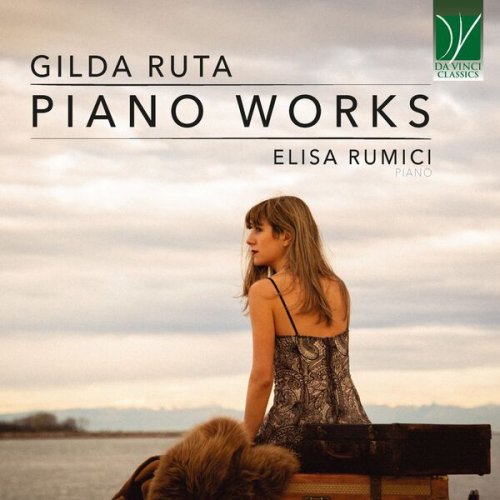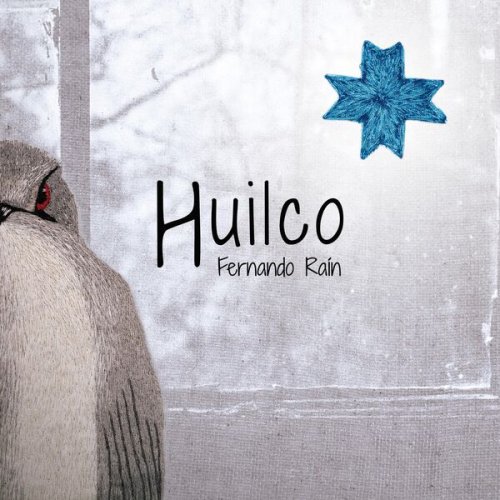Elisa Rumici - Gilda Ruta: Piano Works (2025)

Artist: Elisa Rumici
Title: Gilda Ruta: Piano Works
Year Of Release: 2025
Label: Da Vinci Classics
Genre: Classical Piano
Quality: flac lossless (tracks)
Total Time: 00:53:00
Total Size: 170 mb
WebSite: Album Preview
TracklistTitle: Gilda Ruta: Piano Works
Year Of Release: 2025
Label: Da Vinci Classics
Genre: Classical Piano
Quality: flac lossless (tracks)
Total Time: 00:53:00
Total Size: 170 mb
WebSite: Album Preview
01. Mesta serenata
02. Prima Elegia
03. Primavera
04. Scherzo
05. Allegro appassionato
06. Siciliana
07. Suite a canoni: No. 1, Preludio
08. Suite a canoni: No. 2, Arietta
09. Suite a canoni: No. 3, Sarabanda
10. Suite a canoni: No. 4, Minuetto
11. Suite a canoni: No. 5, Bourrée
12. Suite a canoni: No. 6, Giga
13. Capriccio brillante
14. Bolero
15. Notturno
16. Polacca di concerto
17. Allegro agitato di concerto
Gilda Ruta: a fascinating figure of a woman composer, pianist, singer, but also entrepreneur, teacher, and manager. A figure who lived between two centuries and two continents; a musical personality worth knowing better, appreciating, and celebrating.
Born in Naples on 13 October 1853, the first-born of a bunch of eight siblings, Teresa Emelina Gilda (known simply as Gilda) was the daughter of two musicians. Her mother, Emelina Luisa Sutton (b. 1835) was an English singer, while her father, Michele Ruta (1826-1896) was a true protagonist of his times. He was himself the son and grandson of musicians active at the Royal Palace and the Cathedral of Caserta; indeed, their family includes some fifteen professional musicians between the seventeenth and twentieth century. Michele was a pianist, composer, author, but also a Risorgimento patriot who participated in the uprisings of 1848. He took a very active part in the musical life of Naples, becoming the co-rector of the San Pietro a Majella Conservatory of Naples.
With such parents, and with an impressive talent of her own, it was probably unavoidable that Gilda would be educated as a musician. While her first musical studies took place in her own family, she was soon encouraged to complete her education with other teachers, first and foremost with the great Francesco Saverio Mercadante. Gilda studied composition under his guidance until his death in 1870. Whilst later in her life she began to be hailed as a pupil of Franz Liszt, there is no documentation to prove this element; Gilda herself never made such a claim; however, it is also true that she did not make any effort to disprove it either.
Already as a teenager, Gilda began to be appreciated as a musician in her own right. Francesco Florimo, the highly respected librarian of the Naples Conservatory, mentioned her profusely within the framework of a lemma he was consecrating to her father, in his Cenno storico sulla scuola musicale di Napoli (Historical Draft on the Neapolitan Music School). He wrote: “His daughter Gilda, a young lady of sixteen, is already a distinguished pianist. She is such a promising composer, that she gives us solid hopes for an upcoming, brilliant future. This dear young lady, in spite of her still tender age, is currently a piano and choir teacher at the Elementary School of Terra di Lavoro”.
It was indeed in 1869, when Gilda was sixteen, that her first important successes began to be recorded by the press. She played with her father, but also in academies and concerts in Naples. Here she appeared together with other young musicians who would conquer a place in the history of music, such as Beniamino Cesi, Giuseppe Martucci, Costantino Palumbo, and Alfonso Rendano. Among her first performances is the G-minor Piano Concerto by Mendelssohn, at the Teatro Mercadante with the orchestra of Teatro San Carlo under Nicola de Giosa (March 1875). The same conductor accompanied her on December 28th, 1875, when she played again in Naples.
Two years later, at 24, Gilda got married to a Count and engineer, Raffaele Cagnazzi. As frequently happened to lady musicians at that time, her wedding caused her retreat from the musical scene. Possibly, as the spouse of a nobleman and professional, she did not feel the “need” to maintain her career; or, possibly, she wanted (or her husband wanted her) to focus on their family. Two children were born of their marriage: Tommaso, a future violinist, and Anna, who would become a pianist and piano teacher. However, given the importance that music held for Gilda, it is reasonable to assume that her withdrawal from the stage was merely a reflection of the social conventions prohibiting public performances by married women of high social standing. Sadly, however, Gilda’s conjugal happiness lasted only for a handful of years. At 27, the pianist was already a widow, with two young children to provide and care for. She resumed her musical activity, under her maiden name which was the only under which she had become rather famous. She concertized mostly in Naples, but also in Milan, Rome, and Turin; furthermore, she was also appreciated abroad, with documented and acclaimed performances in Switzerland; An engagement in England—financially most advantageous and secured for her by Giovanni Bottesini—had to be cancelled owing to an illness affecting her son, Tommaso. One of her concerts in Milan met with such success that the Gazzetta Musicale di Milano devoted an entire page to it in its issue of 29 June 1884. Her repertoire, in that period, consisted mainly of the great classics of piano literature (such as Bach, Beethoven, Chopin, Liszt, Schubert, Schumann, Mozart); however, the breadth of her musical interests is revealed by her inclusion of earlier composers, some of whom were little known at her time, and some who are still awaiting their due recognition. Among them were Antonio Sacchini, Ferdinando Turini, Cimarosa and Domenico Scarlatti. Her repertoire included works by contemporaries such as Saint-Saëns, Rubinstein, and Sgambati. Above all, however, she did not neglect to perform her own compositions, which were met with growing appreciation. This translated into a compositional output which was prevailingly consecrated to the solo piano (e.g. Allegro appassionato, Aria di danza , Bourrée, Capriccio brillante, Elegia, Notturno, Partita, Polacca di concerto, Scherzo, Serenata, Zingaresca). There were also works for piano orchestra, such as a Piano Concerto, and pieces of chamber music such as a Sonata for violin and piano, a Romanza senza parole for violin (or cello) and piano. The other major outlet of her creativity was that of art songs (the so-called Romanze da salotto or Romanze da camera), which gained her great acclaim; she frequently performed these in duo with her sister Anna Maria Ida (1862-1944), an appreciated soprano. Arthur Elson wrote that she was “a pianist of great renown, but [who] won her laurels more in the field of composition”.
In 1890, her activity brought her a tangible sign of appreciation. Within the framework of the so-called “Esposizione Beatrice” of Florence, dedicated to the female creativity in any field of art (1890), she was awarded the Gold Medal for musical composition (Beatrice being the beloved and muse of Dante Alighieri, the most famous of the Florentine poets of all times). Music critic Filippo Filippi wrote about her: “Miss Ruta’s compositions are commendable for their undeniable musical merits, but they possess yet another quality that is particularly valuable today: they respond to the widespread need for music – especially for piano – that is accessible to the understanding and technical capabilities of that vast array of honest individuals, amateurs, and young ladies who will be able to read and play Ruta’s music without straining either their brains or their fingers, and above all, without corrupting their taste or offending the ears of their listeners—by which I mean those whose hearts are upright and whose ears are refined”.
After winning the gold medal, Ruta’s career skyrocketed; she played with Italy’s most important orchestras, and also under the baton of a very young and still unknown Arturo Toscanini. The Queen, Margherita of Savoy, was also very impressed by Gilda.
In 1894, Gilda made the most consequential decision of her life—and of her children’s future—when she moved to the United States for reasons that remain unknown, possibly professional but more likely of a personal or sentimental nature. She boarded the German vessel Augusta Victoria in Genoa together with her two children and disembarked in New York on 12 November 1894. The American press hailed her as follows: “Gilda Ruta, a pianist who enjoys the favor of the Italian Court, has arrived in New York. She comes armed with letters of recommendation from Sig. [Francesco] Crispi, the Italian Premier. She is said to possess an exquisite touch, high technical ability and to play with true musicianly fervor. She is also a composer. Personally she is a very attractive woman. A concert at which she will introduce herself to the musical public of New York is being arranged”. Her earliest performances in the United States clearly reveal a deliberate intention to establish herself within the country’s most refined and progressive intellectual circles. She performed at once for the All Nations Club, the Sorosis Club, and—at Carnegie Hall—for the Daughters of the American Revolution, in a concert held in support of Columbia University’s women’s college. In February 1895, she appeared at Madison Square Garden, presenting a programme consisting entirely of her own works. Following a concert in Brooklyn, at the premises of the Wissner piano factory, Gilda became a regular endorser of their instruments. In that same year, The Sun wrote of the Madison concert: “The affair was peculiar, in that its programme consisted solely of the compositions of one person, and that a woman. […] On this occasion Mme. Ruta’s works [including Danza mistica for orchestra, her Piano Concerto and Bolero] were performed by a small orchestra, under Signor Bevignani of the Italian Opera Company, by a chorus of ladies from the Rubinstein Club, and by herself. […] Mme. Ruta demonstrated that she possesses much talent for composing, and considerable also in her piano interpretations. There is a naïveté about her writing as well as about her playing which is not often seen, and which speaks for the sincerity of the woman. She evidently has a keen sense of the meaning of music and much ardent feeling for it”. This concert, with a programme made only of a lady composer’s works, and played entirely by women, was also an important moment in the struggle for women’s rights. In the audience, there were influential gentlewomen who appreciated her, including Anna Mary Palmer Draper, Ellen Louise Demorest, and Cora Slocomb.
Encouraged by such a warm welcome, Gilda established musical institutions of her own: the Ruta Musical Society, and the Ruta Music School (where also her children taught). Her position in the US became one of great prestige, and, at her death on Oct. 26th, 1932, the American press commemorated her with many affectionate obituaries. Italy ignored her passing, perhaps also because it happened to coincide with the celebrations of the tenth anniversary of the March on Rome by the Fascists. If this could be understandable (though unjustifiable), it is even sadder that Ruta remained a forgotten figure for decades in her birth country; only recently has a Ruta-revival started to appear after the book Gilda Ruta. Le due vite di una musicista napoletana, by Giovanni Vigliar, 2019. This album is therefore a very welcome contribution to the reappraisal of her figure and compositions.

![Sibel Köse Septet - In Good Company (2025) [Hi-Res] Sibel Köse Septet - In Good Company (2025) [Hi-Res]](https://www.dibpic.com/uploads/posts/2025-12/1765846644_uizwujac4ht2d_600.jpg)

![Betty Carter - The Music Never Stops (2019) [Hi-Res] Betty Carter - The Music Never Stops (2019) [Hi-Res]](https://www.dibpic.com/uploads/posts/2025-12/1765896843_bcmn500.jpg)

![Demo Rumudo - Second Nature (2025) [Hi-Res] Demo Rumudo - Second Nature (2025) [Hi-Res]](https://www.dibpic.com/uploads/posts/2025-12/1765883076_cover.jpg)
![Coco Chatru Quartet - Lost Christmas (2025) [Hi-Res] Coco Chatru Quartet - Lost Christmas (2025) [Hi-Res]](https://www.dibpic.com/uploads/posts/2025-12/1765719561_coco-chatru-quartet-lost-christmas-2025.jpg)
![Afrodream - Guiss Guiss (2025) [Hi-Res] Afrodream - Guiss Guiss (2025) [Hi-Res]](https://www.dibpic.com/uploads/posts/2025-12/1765638325_a2717494732_0.jpg)
